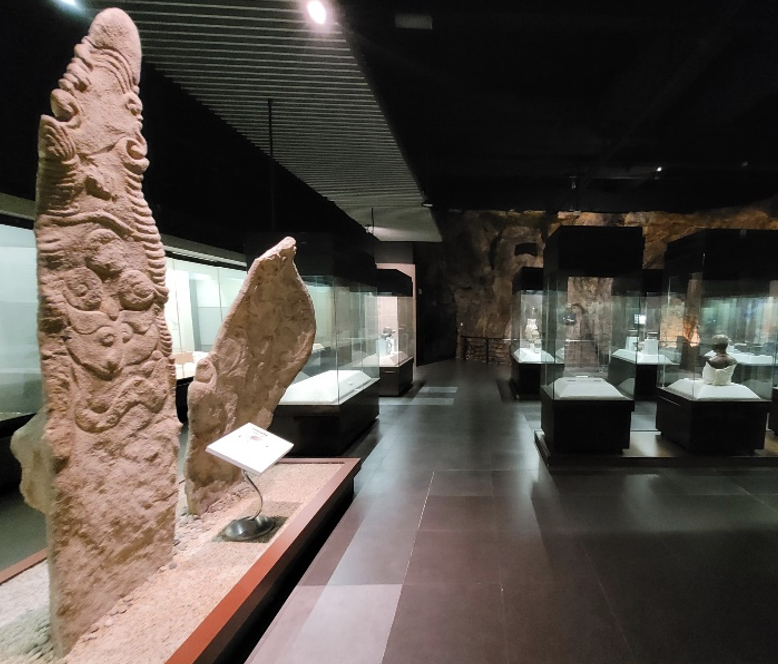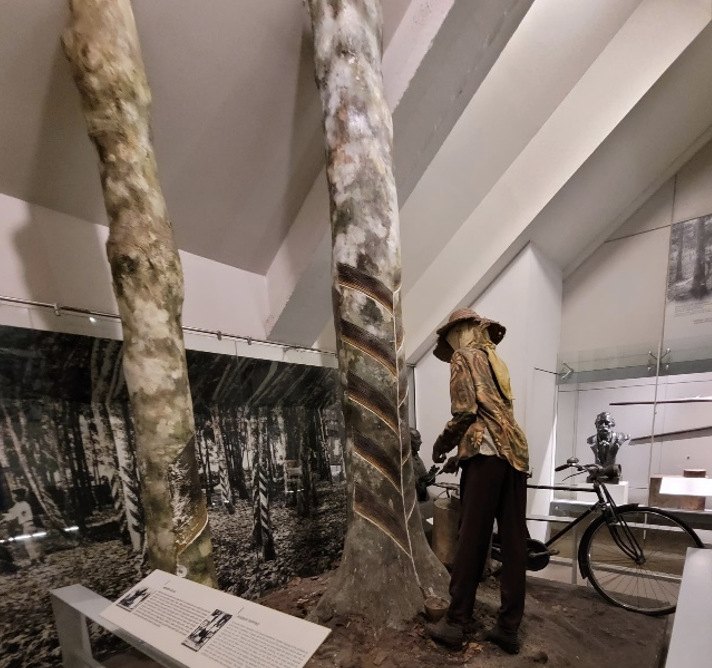By Sarjit Kaur
As visitors walk through the halls of the museum, they become enveloped in a symphony of sounds that pulse with centuries’ past. Each artefact and diorama emit a vibration, a sensation, telling stories of triumph and defeat, rituals and practices, layering and blending of cultures. Every journey is the start of a story… and what better way to pay homage to our stories than through the art of listening.
Whispers of Stones and Ancient Artworks
The museum walls hold a world of ancient mysteries and forgotten civilizations, with stone tools and ancient artworks offering glimpses into the lives of our ancestors. Stones, once raw and jagged were skillfully crushed, smoothened, sharpened and refined, like a Chef’s set of knives that crush, cut and slice.
Rock art, that adorn cave walls speak of a time when black charcoal and red hematite were splashed across limestone canvas, like a mural, capturing and documenting rituals and ceremonies. Each whispered their stories, the heart-beat of the people.
Larger rocks were artistically sculpted into stone tablets, makaras and statues of beauty and grace. Towering megaliths, inscribed with salient iconography stand as silent custodians, bearing witness to the diverse layering yet harmonious practices that bound humanity.

The sounds of diversity and harmony
Dong Son Drum and Bell
The Dong Son bronze drum and bell, found in various states of the Peninsular, bear motifs similar to those from Dong Son, North Vietnam, indicating long-distance land trade in South East Asia.
The Dong Son drum, a sacred instrument, was used during harvest festivals, weddings and burials to call upon nature and ancestral spirits. When struck, it produced a powerful, resonating vibration that filled the air.
The bell, likely hung around a ceremonial animal’s neck, served as a war warning and also used to store food for the wealthy. The bell’s rich, resonant tones marked its value and the social class of its owner, similar to today’s luxury items.

The resonance of the Dong Son bell and drum
Gamelan: A Percussive Symphony
The Malay palace door invites visitors with its tranquil and grounding sound of the gamelan. Echoes of this ancient melody resonate with the soul of the Malay world. Where it was once the exclusive domain of aristocrats; the gamelan is now enchanting music for all!
Meanwhile… accompanied by an orchestra of gamelan music, the ‘Tok Dalang’ weaves epic tales in his Shadow Play; as audience cheered, laughed and reflected on the moral and spiritual lessons conveyed.

The enchanting sounds of ancient instruments
The Sounds of Trade
The bustling trade activity in the Straits of Malacca resonated with the voices of Captains as they navigated and competed for harbouring space amongst ships. In this maritime symphony, traders conversed in 84 languages, striking deals and exchanging goods from distant lands.
Spices like pepper, cloves, nutmeg and cinnamon were measured meticulously with conventional weighing instruments for proper governance. These aromatic treasures were sought-after in the markets of Europe, their scents mingling with the salty sea breeze. Silk fabrics and gold brocade, known for their luxurious feel and vibrant colours, were another commodity transported from the Silk route of China. Delicate and beautifully crafted porcelain ceramics exchanged hands, their chime ringing through the marketplace.
Within the hustle and bustle, foreign traders forged connections with the land and its people. They fell in love not only with the promise of prosperity but also with the allure of the local women. While they settled amidst the shifting winds of trade and romance, they blended and became part of this vibrant Malay Archipelago.
Waves of Tales
Seafarers braved and navigated open and treacherous seas. Their courage come alive through the sounds of their flowing sails and crashing waves on uncharted waters. Their heroic journeys were threaded with peril and adventure, heavily relying on monsoon winds as their compass and invisible force.
Stars twinkle overhead in the limitless sky, reflecting their aspirations for trade opportunities in distant lands. Yet, some never reach their destinations, as storms and hidden reefs swallow their voyage quest. Their ships sank together with their precious cargoes.
The marine gateway of South China Sea holds treasures of countless blue cobalt porcelains. Though discoloured, they stood the test of time, telling sunken tales of their journey. Yet many goods were never discovered and remain thrones of the sea. Maybe they needed to be laid to rest, closer to their home…
Arms of Conflict
Iron ore which were smelted under fiery heat, gave birth to the legendary ‘keris’ Local artisans carved each sheath into superior pieces of art. Each blade carried stories of origin and purpose, evoking accounts of power, loyalty and friendship. The clashing of metal on metal, tells of battles fought and victories won or redeemed.
Weapons evolved into modern instruments of war such as guns and large cannons, which ultimately met the same fate of devastation, whether it was the conquest of Melaka or the devastation of Pearl Harbour. These events underscored the transformation of humanity from ‘hunters for survival’ to ‘conquering hunters’, driven by the pursuit of power and wealth. However, history teaches us that every rising power eventually faces its downfall…
Turning Wheels: A Twist of Fate
The wheels of the bicycle tirelessly spin in the terrains of rubber estates accompanied by a sonata of insect sounds. Where needed, the bell attached to the bicycle rings out, signalling the arrival of workers to tend to the rubber trees. The latex from the cup is collected and poured into a metal container, flowing like thick milk. Each drop was precious. Amidst the tranquillity of the estates, the occasional rustle of leaves and movements of wild animals, remind visitors of the natural yet tough conditions surrounding them.

The industrious sounds of bicycle and latex
As the nation’s income surged from the export of rubber and tin, Malaya embarked on a transformative journey of infrastructure development, constructing railway tracks and roads to facilitate the transportation of these vital commodities. The rhythmic clatter of steel wheels on tracks and the hum of engines became the soundtrack of progress, echoing the promise of prosperity. This era witnessed an influx of migrant workers, their voices mingled with the sounds of construction, embodying the spirit of resilience and determination.
However, a shadow loomed over Malaya on 8 December 1941. Bicycles – once the symbol of peaceful transportation; were swiftly transformed into instruments of war, as infantry soldiers mounted on them for battle. It forever altered the landscape of Malaya. The terror of war wounded many, a stark reminder of how fragile life can be, when peace is robbed of humanity.
Education – The Song of Catalyst
Schools served as reservoirs of knowledge, sparking enlightenment and offering a future, brighter than that of their ancestors. Within the walls of Malayan classrooms, a symphony of languages reverberated, celebrating diversity.
Education served as the catalyst and bridge for expanding minds, fostering awareness and laying the groundwork for Malaya’s independence. From these halls, emerged writers, poets, activists and peacemakers who reshaped societal norms and fuelled the collective dream that – “We too can be the Masters of our Land!”

The liberating sounds of typewriter-keys clacking
Timeless Reminders of Songs
Amidst the echoes of the past, cultural songs and anthems serve as reminders of the more recent history. ’Dondang Sayang pantuns’ and ‘Jingling Nona’ songs represent the rich cultural tapestry of Baba Peranakans and Portuguese Peranakans respectively – the blend of various cultures with the Malay culture.
‘Negaraku’ – our national anthem, symbolised the birth of a nation and became a uniting force among the people. It echoes thru the halls of the museum, for all to hear. And yet it brings goose bumps to older visitors and people of the land, who walked the pre-independence journey with courage and strength.

The sounds of unison of an independent nation
The Sounds of Silence and Rhythm
In the silence of the museum, the sounds of history come alive, inviting us to immerse in the richness and diversity of the human history.
Each sound, each note tells a story. As visitors pause and listen, they become part of that story. Their own experiences merging with those of the past. It is a testament to the power of sound – both the silence and rhythm, to connect with our shared heritage, learnings from the past and into the future. The sounds of museum echoes thru the walls … a moving reminder of the beauty and resilience of the human spirit.
Photo credit: Sarjit Kaur
